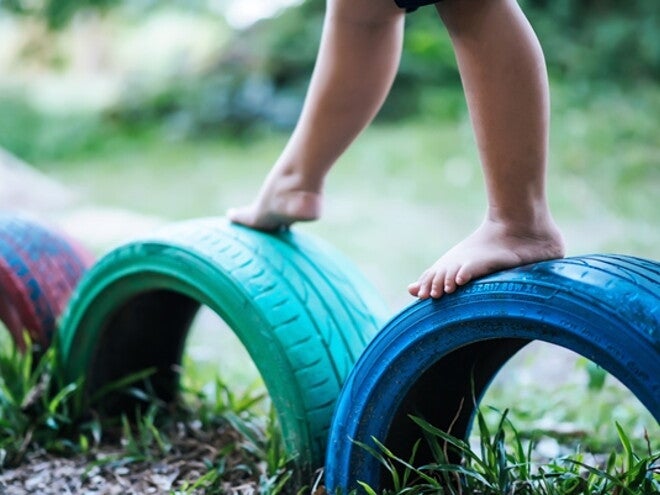
55 months Milestone
Certain physical activities build confidence and develop core strength and stability in 4 ½ years-olds.
Wheelbarrow walking: Your child can now walk forward rhythmically on extended arms with support at the hips, and later at the ankles.
Somersaulting: Many children of this age still fall sideways as they roll over. As their fifth birthday approaches, they typically learn to tuck their chins in and roll onto their backs. Some even learn to roll over twice.
Clambering on jungle-gyms: At this age, children typically climb by pulling up with one hand, followed by bringing their other hand up to it. Encourage your child to practice looking up as they climb and as their fifth birthday approaches, demonstrate how to climb a ladder with alternating arm movements.
How body awareness boosts confidence and learning readiness
At birth, babies have no idea that they exist in bodies, nor what their body parts can do.
Developing body awareness
Children develop a sense of their own bodies by physically interacting with their environment. As they move around, handle objects and play, their senses send information to their brains about their space. This helps them build an idea of what their bodies look like and where all their body parts are in relation to each other and the objects around them, without thinking about it.
As children move, they learn how much space their body parts occupy and how these parts work together. They also learn about rhythm, speed, distance and the amount of pressure required to perform tasks.
Sensory systems
Two sensory systems play a hugely important role in body awareness known as the vestibular and proprioceptive systems.
The vestibular system is situated in the inner ear. It controls a person’s sense of balance and spatial orientation. It constantly sends movement information to the brain.
The proprioceptive system consists of a network of special receptors in our muscles, tendons and joints. This forms a continuous feedback loop with the nervous system and sends information to the brain about the position of our body parts in relation to each other as well as objects in the environment.
Decreased body awareness
Children who have issues with sensory processing lack body awareness. This leads to clumsiness and low self-confidence. Children with low body awareness may, for example, put too much pressure on a pencil when they draw or write. If they struggle to use the two sides of their bodies together, they have trouble guiding a piece of paper with one hand, while cutting with a pair of scissors in the other.
Body awareness forms a foundation
Body awareness connects a child with their environment from the very core of their physical experience (the body). As a result, it develops parallel to many other developmental skills. In fact, many of the “higher mental skills” cannot develop fully when there is something amiss with a child’s sense of their body. As an example, children have difficulty placing objects relative to other objects when they haven’t yet developed an awareness of how they can position their own bodies in relation to objects.
Before a child can learn to read and write, they need to grasp how circles and lines can be connected to create letters. This skill is called visual-motor integration.
Practically speaking, a child has to be able to physically walk in the shape of a diamond and draw a diamond with a finger in the air, before the child will be able to visualise how three loose lines can be connected to draw a triangle on paper.
The connection between a child’s physical development and learning readiness is not obvious. Therefore physical education and play are vitally important.
Tip: How to promote body awareness and balance
To give your child’s sense of body awareness and balance a boost, build an obstacle course that requires rolling on the floor between two points before stepping over, crawling under, running around and climbing over obstacles.
This teaches children about the rhythm, space, direction and pressure needed to move in different ways and explore what their body can do.
A few suggestions:
- Create a tunnel (open ended box) for them to crawl through.
- Suspend a broom across two chairs for your child to go under while crouching.
- Use chalk to indicate where to do frog jumps or bunny hops on the driveway.
- Draw arrows on paper scraps or use a length of yarn to lay out a path to follow.